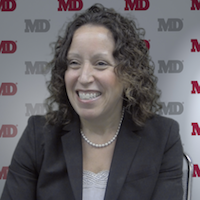Q&A: Jacqueline Montes, PT, on Spinraza's Improvements for SMA Fatigability
Montes' team found benefits in motor function, walking ability, and fatigue in patients to undergo nusinersen (Spinraza) for spinal muscular atrophy.

Jacqueline Montes, PT
Interim research presented at the 70th annual meeting of the American Academy of Neurology (AAN) in Los Angeles, CA this week, showed the SHINE open-label extension study and CS2/CS12 studies found benefits in motor function, walking ability, and fatigue in patients to undergo nusinersen (Spinraza) for SMA.
Jacqueline Montes, PT, of Columbia University and lead study author of the CS2/CS12 trials, sat down with MD Magazine while attending the AAN meeting and discussed the significance of her team’s finding for a debilitating, if not frequently deadly, neurodegenerative disease.
Kevin Kunzmann, MD Magazine: Your team has been a part of these trials?
Jacqueline Montes, PT: Yes. At Columbia, we dosed the first patient ever in CS1 in December 2011. It’s been a long and wonderful journey.
Could you detail what some of these findings have been?
The program moved quite quickly from the initial studies to the index studies, but my work here that I’m presenting focuses on CS2/ CS12 open-label studies in later onset SMA. It included children aged 2-15 years old, and I focused on the small cohort of that population that were ambulant. Our subset included 34 patients in the CS12 that were ambulant. And we measured 6-minute walk test, as that resembles ambulatory function. We also know we can measure fatigability with the 6-minute walk test.
Fatigability is a big problem in neuromuscular disease, especially in SMA. It’s important to see how we can modify it. Our results show that the patients that were enrolled in CS12 that were treated for 3 years have a 98-meter improvement on the 6-minute walk test, and that’s important for a few reasons. As a researcher, this is outside the norm of natural history. In natural history, there’s never an improvement and there’s often a decline particularly in vulnerable patients. Any improvement would be wonderful, but this is a big improvement.
So, this improvement of 98 meters really can translate to something meaningful to these children and adolescents. So, if you can imagine being able to walk farther might translate to being able to walk with your peers from class to class in high school or at social events. In addition, we saw a corresponding decrease for destabilization and fatigability.
That fatigability is measured as a change in velocity over time in the 6-minute walk test, and if you can imagine how it feels to not be able to keep up — like running a marathon and starting off really fast and then you get really slow. Well, walking down the block is like a marathon for these patients. To modify that experience and fatigability is a big deal.
That really puts it in perspective. Could more explain the significance of it being ambulatory patients?
The index studies that helped to get the approval for Spinraza focused on infantile-onset and later-onset non-ambulatory patients. The FDA was insightful enough to know to provide a broad label to the drug, so all patients, regardless of age or type, can get treatment.
But we don’t know exactly what those benefits can be. And I think this study could be important to highlight that, even in the milder phenotypes, there could be meaningful benefit to treatment.
Regarding any follow-up or extension of this study — what’s planned?
Well, the data is still ongoing, so the patients that were in CS 2 or 12 continue on in open-label study, and we will most certainly continue to follow them. They continue to make gains, so we’re really excited about that. We’re excited to see the next wave of data and experience.
I can imagine. So, what’s a tangible goal to reach for with this therapy?
Actually, we think about it a lot, and there are other projects going on to examine it, but they’re not comparable to their peers just yet. They’re still well below their expected performance, so normative data speaks to a good comparison. If you’re treating a disease, you would want them to look like their peers. I think there’s many goals to reach for. While the improvements are exciting, we haven’t hit the top, so to speak.
Click here to sign up for more MD Magazine content and updates.
The American Academy of Neurology Annual Meeting (AAN) delivers the latest developments in science, education, and networking, and further coverage can be found at MD Magazine‘s new sister site, NeurologyLive.
Related Coverage >>>
Liquid Therapy RG7916 Improves Protein Levels for Infants with SMA
Nusinersen Reports Multiple Motor System, Survival Benefits for Spinal Muscular Atrophy